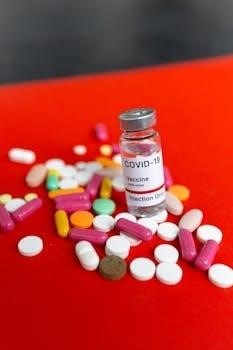
Materia Medica PDF⁚ A Comprehensive Guide
Materia Medica, a cornerstone of homeopathic and herbal medicine, is extensively documented. This guide explores Materia Medica PDFs, offering remedy information, symptoms, and clinical indications. It will cover accessing resources, including free online ebooks and downloads for in-depth study.
What is Materia Medica?
Materia Medica, derived from Latin, translates to “medical material,” serving as a comprehensive resource in fields like homeopathy and herbalism. It is essentially a detailed compilation of knowledge about various medicinal substances, encompassing their origins, preparations, and therapeutic properties. Specifically, it documents the effects of remedies on healthy individuals through “provings,” meticulously recording the symptoms elicited. This information then guides practitioners in selecting the most appropriate remedy based on the principle of “similia similibus curentur” – like cures like, matching the patient’s symptoms with the remedy’s proving symptoms for effective treatment. Boericke and Kent are examples.
Historical Significance of Materia Medica
Materia Medica holds immense historical importance, tracing back to ancient pharmacopoeias like Dioscorides’ “De Materia Medica.” This foundational work, alongside Hahnemann’s “Materia Medica Pura,” shaped medical practice for centuries, influencing both traditional and homeopathic medicine.
Dioscorides’ De Materia Medica
Pedanius Dioscorides, a physician in the Roman army during the first century CE, authored “De Materia Medica,” a five-volume pharmacopoeia. This comprehensive work described medicinal plants and the medicines derived from them. Copied and adapted throughout Europe for 1500 years, Dioscorides’ book remained the foremost pharmaceutical source of antiquity. It detailed plants observed during his travels with Roman legions across Greece, Italy, Asia Minor, and Provence. His herbal offered extensive knowledge of plants, their properties, and preparations, playing a critical role in the development of medical practice. It’s considered a cultural heritage.
Hahnemann’s Materia Medica Pura
Samuel Hahnemann’s “Materia Medica Pura,” a foundational text in homeopathy, comprises six volumes detailing the effects of remedies on healthy individuals. This groundbreaking work documents drug provings, the systematic testing of substances to understand their therapeutic potential. Hahnemann meticulously recorded the symptoms elicited by each remedy, providing a detailed understanding of their action. Volumes I and II reached a third edition, while the remainder remained in the second edition. “Materia Medica Pura” remains a cornerstone for homeopathic practitioners, guiding remedy selection based on the principle of therapeutic similitude. It’s an essential resource for understanding homeopathic medicine.
Key Figures in Materia Medica Development
Several key figures shaped the development of Materia Medica. These individuals contributed significantly to expanding our knowledge of remedies, drug provings, and clinical applications. Their work remains foundational to homeopathy and herbal medicine today.
Samuel Hahnemann
Samuel Hahnemann, the founder of homeopathy, stands as a pivotal figure. His Materia Medica Pura is a cornerstone of homeopathic literature. Hahnemann meticulously documented drug provings. He aimed to understand the effects of substances on healthy individuals. His work revolutionized therapeutic approaches. He emphasized individualized treatment. Hahnemann’s meticulous approach to remedy selection and understanding drug actions laid the foundation for modern homeopathic practice. His Materia Medica Pura consists of six volumes detailing his research. These volumes remain essential resources. They provide insights into the characteristics of various remedies. Hahnemann’s legacy continues to inspire practitioners and researchers alike.
William Boericke
William Boericke, a prominent figure in homeopathy, is best known for his concise and practical Materia Medica. This work, frequently updated, presents a compilation of homeopathic remedies, incorporating verified symptoms and clinical experiences; Boericke’s Materia Medica serves as an accessible guide for practitioners. It provides keynotes and characteristic symptoms for various remedies, aiding in remedy selection. His organized presentation of remedies makes it a valuable tool for both students and experienced homeopaths. The ninth edition of Boericke’s work remains a widely used reference. It offers a condensed yet comprehensive overview of homeopathic therapeutics, facilitating effective clinical application.
James Tyler Kent
James Tyler Kent, a towering figure in homeopathy, significantly influenced the field with his profound understanding of Materia Medica and philosophy. His “Lectures on Homoeopathic Materia Medica” is a seminal work, exploring the deeper essence of remedies. Kent emphasized understanding the patient’s totality of symptoms, including mental and emotional aspects. His detailed descriptions of remedies provide a comprehensive understanding of their sphere of action. Kent’s approach focuses on individualization and the selection of the simillimum. His teachings and writings continue to inspire homeopaths worldwide, offering invaluable insights into the application of homeopathic principles and remedy selection in practice.

Accessing Materia Medica in PDF Format
Finding Materia Medica PDFs is easier than ever. Many free online resources and ebook downloads are available. These digital versions provide convenient access to essential homeopathic knowledge for practitioners and students alike.
Free Online Resources
Numerous websites and digital archives offer free access to Materia Medica PDFs. These resources often include digitized versions of classic texts by renowned figures like Boericke, Kent, and Hahnemann. Online libraries provide searchable databases, allowing users to quickly find information on specific remedies and their associated symptoms. Many homeopathic organizations and educational institutions also maintain online repositories of Materia Medica information in PDF format. Furthermore, projects like the World Digital Library and the Internet Archive host digitized versions of historical texts, making them readily available to researchers and students worldwide. These free resources democratize access to vital homeopathic knowledge.
E-book Downloads
For convenient offline access, many Materia Medica texts are available as e-book downloads, primarily in PDF format. Several websites dedicated to homeopathy and alternative medicine offer these downloads, sometimes for free or at a nominal cost. These e-books often include searchable text, making it easier to find specific remedies or symptoms. Popular titles such as Boericke’s Materia Medica and Kent’s Lectures on Homeopathic Materia Medica are widely available for download. Users should ensure that the downloaded files are from reputable sources to avoid corrupted files or inaccurate information. PDF versions allow for easy reading on various devices, including tablets, e-readers, and computers.
Content of a Typical Materia Medica PDF
A Materia Medica PDF typically contains detailed information about homeopathic remedies. This includes their origin, preparation, key symptoms, and clinical indications. Understanding this content is crucial for effective remedy selection and application in homeopathic practice.
Remedy Information
Within a Materia Medica PDF, remedy information is paramount. Each entry details a specific substance, often derived from plants, minerals, or animals, prepared according to homeopathic principles. The remedy’s origin, common name, and preparation method are typically included. Furthermore, the PDF provides insights into the remedy’s “proving” symptoms—effects observed when administered to healthy individuals.
This section also encompasses the remedy’s sphere of action, outlining the organ systems or tissues most affected. Keynotes, or characteristic symptoms unique to the remedy, are highlighted to aid differentiation. Understanding this comprehensive remedy profile is essential for accurate prescription.
Symptoms and Clinical Indications
A Materia Medica PDF’s strength lies in its detailed compilation of symptoms and clinical indications for each remedy. These symptoms are meticulously gathered from “provings,” toxicological data, and clinical experience. The symptoms are presented in a structured format, often categorized by body region or system; This allows practitioners to quickly identify remedies matching a patient’s unique symptom picture.
Clinical indications provide guidance on specific diseases or conditions where a remedy has proven effective. These indications are based on observed patterns of symptom relief in clinical practice. The PDF serves as a reference for selecting the most appropriate remedy.

Using Materia Medica in Practice
Using Materia Medica in practice involves carefully comparing a patient’s symptoms with the detailed remedy profiles. Understanding drug provings and accurate symptom selection are vital for choosing the correct remedy.
Selecting the Correct Remedy
Selecting the correct remedy from a Materia Medica PDF involves a meticulous process of comparing the patient’s unique symptom picture with the detailed descriptions of each remedy. This includes carefully considering the modalities, concomitants, and characteristic symptoms associated with the patient’s condition. Accurate observation and thorough case-taking are essential prerequisites. Consulting multiple Materia Medica resources and cross-referencing information is crucial. Understanding the nuances of each remedy, as documented through drug provings, aids in identifying the simillimum. The goal is to find the remedy whose symptom profile most closely mirrors the patient’s overall presentation.
Understanding Drug Provings
Understanding drug provings is fundamental to effectively utilizing a Materia Medica PDF. Provings are the systematic process of testing substances on healthy individuals to determine their potential therapeutic effects. The symptoms experienced during these provings are meticulously recorded and form the basis of the remedy pictures in the Materia Medica. These symptoms, detailed in PDFs, include mental, emotional, and physical manifestations. Studying the methodology of provings helps to appreciate the reliability and significance of the information contained within the Materia Medica. Hahnemann’s Materia Medica Pura provides insights into these original provings. Recognizing the source and context of these symptoms is crucial.

Modern Applications of Materia Medica
Modern applications involve integrating it into modern medicine by using Materia Medica PDFs for research and development. This includes exploring drug interactions, understanding therapeutic effects, and informing clinical practice. It’s a resource for novel treatment strategies.
Integration with Modern Medicine
The integration of Materia Medica with modern medicine involves utilizing its detailed remedy information in conjunction with contemporary scientific research. PDFs provide accessible resources for exploring potential synergistic effects between homeopathic treatments and conventional pharmaceuticals. Analyzing verified symptoms aids in personalized medicine approaches, enhancing treatment efficacy. Furthermore, understanding drug provings contributes to identifying novel therapeutic applications and mitigating adverse effects. This integration fosters a holistic approach to patient care, merging traditional wisdom with modern scientific advancements for comprehensive healthcare solutions, while leveraging readily available Materia Medica PDFs.
Research and Development
Research and development in Materia Medica are fueled by the wealth of information contained within PDFs, enabling comprehensive data analysis. Researchers explore remedy properties, clinical indications, and symptom patterns to identify potential therapeutic targets. Drug provings, detailed in Materia Medica, guide the development of new homeopathic medicines. Furthermore, studying historical texts alongside modern clinical trials helps validate traditional uses and uncover novel applications. Utilizing PDFs facilitates collaborative research, allowing scientists to share findings and accelerate advancements. This rigorous approach enhances the scientific understanding of Materia Medica and promotes innovation for improved patient outcomes.
Resources for Further Study
For deeper exploration of Materia Medica, numerous resources exist. These include online libraries and archives offering PDFs, as well as homeopathic organizations. Further study enhances understanding and application of this vital medical resource.
Online Libraries and Archives
Numerous online libraries and archives offer access to a wealth of Materia Medica PDFs. These digital repositories often contain digitized versions of historical texts, including works by prominent figures such as Hahnemann and Boericke. Exploring these archives allows researchers and students to delve into original sources and trace the evolution of homeopathic and herbal knowledge. Many offer free downloads or online viewing options, making them accessible to a global audience. Resources like the World Digital Library and the Internet Archive are invaluable for finding rare and out-of-print Materia Medica books in PDF format. The Digital Library of India also provides digitized books.
Homeopathic Organizations
Several homeopathic organizations play a crucial role in preserving and disseminating information about Materia Medica. These organizations often maintain libraries and archives containing Materia Medica PDFs, accessible to members and researchers. They may also offer online resources, such as digitized texts and databases of remedies. Furthermore, these organizations frequently host conferences and workshops where experts share insights on using Materia Medica in practice. Some organizations, like the National Center for Homoeopathy, contribute to preserving and making available historical texts. Exploring the websites of these organizations can provide valuable access to Materia Medica resources and educational opportunities, often providing links to PDF versions.
